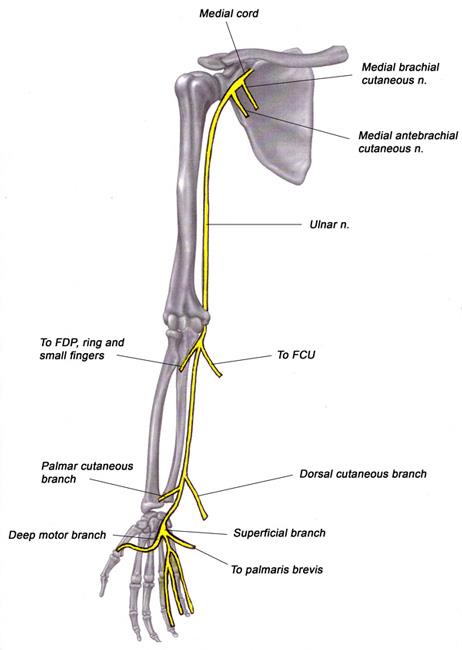
Most people have experienced an occasional pins and needles sensation, usually when falling asleep in a funny position. Normally, the numbness goes away relatively quickly with shaking it out or walking around.
But what happens when you’re starting to get funny symptoms just on your inside two fingers – your ring finger and pinky finger – and they seem random but progressively getting worse? If it’s not painful… it’s not a problem… right?!?
If you experience tingling, numbness, pins and needles, or burning in your 4th and 5th fingers, you may have a type of ulnar nerve entrapment.
Have you ever hit your funny bone? (For those of you that are uninformed of this grade school slang, your funny bone is your elbow!) When you hit the inside of your elbow on something, you may have an intense pain down your forearm and may even have tingling symptoms temporarily. This is actually your ulnar nerve that you just whacked!
Anatomy Break
Let’s take a closer look at where this ulnar nerve is.
Your ulnar nerve runs from your shoulder down the inside/back of your elbow right between the pointy part of your elbow (olecranon) and the inside body bump on your elbow (medial epicondyle). There’s a groove in between these two bony parts where the ulnar nerve hangs out which is called the Cubital Tunnel. It supplies some muscles of the forearm that help to
1. Bend the wrist towards the front of your forearm (wrist flexion) and
2. Bend your wrist in towards the inside of your forearm (ulnar deviation).
Then it makes its way through the forearm to come through an area called the Guyon Tunnel in your hand, to supply the sensation to 5th finger, and the inside of the 4th finger, and send messages to muscles that
1. Contribute to grip strength, 2. Pull your thumb in towards your 2nd finger, and
3. Control the 4th and 5th fingers.
What exactly is ulnar nerve entrapment?
Ulnar nerve entrapment is when the ulnar nerve becomes sensitive and starts creating altered sensations or altered motor function in your arm or hand.
This sensitivity could be created by repetitive movements, overstretching the nerve, or could be from an acute injury that irritated the nerve.
It may or may not mean that the nerve is actually “stuck” or “entrapped” in your tissues (but it sure does sound more dramatic, right?!). Ulnar nerve entrapment is not specific to the location of the problem, which means that there are different types of ulnar nerve entrapment that may be treated slightly differently.
What are the common types of Ulnar Nerve entrapment?
Cubital Tunnel Syndrome is the most common site of ulnar nerve entrapment. This irritation happens at the inside of the elbow in the Cubital Tunnel. This is more common in racquet sports players, and baseball players. It may be most irritatable with elbow motions and pressure at the elbow.
Guyon Tunnel Syndrome is the ulnar nerve irritation that occurs in the base of the hand at the Guyon Tunnel. This is less common, but can occur with trauma to the hand or wrist or repetitive trauma to the area of the Guyon Tunnel. It may be most irritable with pressure or motions at the wrist.
It is possible for the nerve to become irritated at other sites along the path of the nerve as well.
Do I really need to treat this?
Tingling symptoms are a sign of your nerves not being 100% healthy. This is a sign to work to increase their health.
Even if it’s not painful, it is wise to address tingling symptoms promptly and to eliminate them if possible to desensitize your nervous system and prevent future problems. If you leave it as it is, it may become more frequent or intense, and it may start becoming painful – at which time it will take longer for it to get better.
If this condition worsens further, you may find that you have weakness in your grip strength, weakness in your pinching grip between your thumb and 2nd finger, and some weakness in wrist flexion.
Treatment
So you know that you’ve got these symptoms, now what are you going to do about it?
Avoid aggravating activities
-Avoid resting your elbow on the window in the car – a common aggravating resting posture in the car!
-Avoid resting elbows on the dinner table
-Avoid prolonged positions of elbow bending (all the way) or straightening (all the way) – especially while sleeping ie. sleeping with your hand underneath your head while on your side
-Avoid repetitive bending and straightening your elbow
-Take a break from racquet sports and throwing sports which involve pulling your arm from behind you to in front of you while leading with the inside of your elbow and “whipping” your hand through with high intensity (tennis, throwing a baseball, etc) – especially if this is painful or brings on your symptoms
-Take a break from positions that put a lot of pressure on the base of your hand, like resting your hand on the handlebars while cycling, if it aggravates your symptoms
Use a brace or night time splint
One of the easiest ways to calm the nerve down is to help support it in a “resting position” at the elbow while sleeping at night. A night time ulnar nerve splint can prevent you from overstretching your ulnar nerve at your elbow accidently while you sleep, and can help manage your day time symptoms by starting off your morning less irritated.
If your symptoms appear more consistent with Guyon Tunnel Syndrome, a wrist brace or splint to help support the area and prevent excessive motion of the nerve at the wrist can be helpful.
Ulnar nerve floss
An ulnar nerve floss can help glide and slide your nerve throughout your arm to help bring blood flow to the nerve and help to desensitize the nervous system to decrease symptoms overtime. Sidebending your neck towards the problem side can actually decrease the symptoms felt with this movement and help you move farther, more comfortably! You will bring your 2nd finger to your thumb and then get the palm of your hand to be against your face, while pointing your fingers towards the ground. Relax out of the position and then repeat.
Above is the full version of an ulnar nerve floss. This is an intense way to get at those symptoms and start desensitizing the nerve. But what if it’s extremely painful, or if your symptoms increase significantly afterwards (for more than just a few minutes), what do you do?
You may need to do a more gentle version of this floss. The modified version involves less arm movement and less stretching of the ulnar nerve. Bring your hand facing away from you up beside your head with your elbow at 90 degrees. Bring your fingertips towards your head, so that your palm faces the ceiling. Return to the starting position and repeat.
Tips :
Perform gently and slowly.
You can do this floss for 10 repetitions, 5-10x/day!
Heat versus ice?
Heat – it will warm up the muscles and bring blood flow to the nerve and the surrounding tissues to help it move around with less pain. Your ulnar nerve floss will also feel better after heat too!
No ice! The nerve is located very close to the skin in the elbow in particular and can be very sensitive to ice. Icing can actually cause further injury if overdone.
One thing to keep in mind is that the nervous system is one continuous mesh of nerves, which means that movements up at the neck, could create symptoms down at the hand. This is why it’s important to identify the aggravating movements to create a treatment plan to address the problem area. The problem area may actually be in the shoulder or the neck, in the nerves that are higher up in the body BEFORE they become the ulnar nerve. A physiotherapist will be able to fully assess your symptoms to investigate the diagnosis and identify your aggravating activities to give you personalized advice to manage your symptoms.
Not sure how you’re going to get those tingling hand symptoms under control? Call us at 519-895-2020, or use our online booking tool on www.strivept.ca to book an appointment with one of our knowledgeable physiotherapists, and they will be sure to help you understand your injury.
Cheers,
Amanda McFadden
